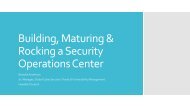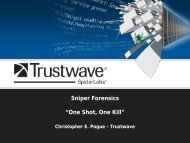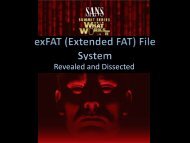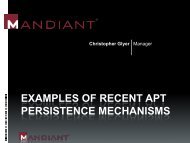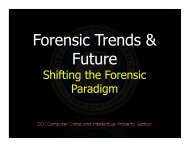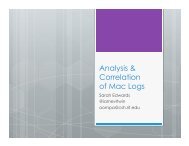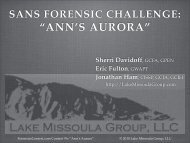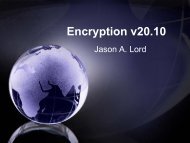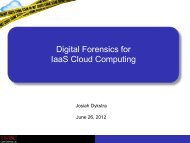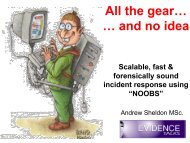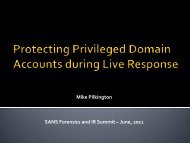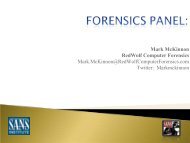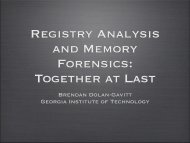Advanced file carving - SANS Computer Forensics
Advanced file carving - SANS Computer Forensics
Advanced file carving - SANS Computer Forensics
Create successful ePaper yourself
Turn your PDF publications into a flip-book with our unique Google optimized e-Paper software.
<strong>Advanced</strong> <strong>file</strong> <strong>carving</strong><br />
How much evidence are you ignoring?<br />
Bas Kloet, Hoffmann Investigations<br />
September 2010
Who am I?<br />
• Bas Kloet:<br />
• Digital Forensic Investigator at Hoffmann Investigations<br />
since 2007<br />
• Master project: File <strong>carving</strong>…<br />
• Hoffmann Investigations:<br />
• Founded in 1962<br />
• Currently about 80 employees, 1000 cases per year<br />
• Fraud, theft, industrial espionage
About this presentation<br />
Based on a full day training<br />
Contents:<br />
1. Carving and basic <strong>file</strong> information<br />
2. File Systems and Fragmentation<br />
3. General File Carving Techniques<br />
4. Measuring File Carving Quality<br />
5. Specific Purpose Carving Tools
Topic 1 - (File) Carving<br />
Carving is a general term for extracting structured<br />
data (<strong>file</strong>s) out of raw data, based on format<br />
specific characteristics present in the structured<br />
data.
Topic 2 - File Systems and Fragmentation<br />
• Files are stored in <strong>file</strong> systems<br />
• Windows (FAT 12/16/32, NTFS)<br />
• Linux (Ext2/Ext3/Ext4, Reiser)<br />
• Mac (HFS, HFS+/HFSX)<br />
• File systems store data in clusters or blocks<br />
• Files are usually stored sequentially by the OS on media
FAT File Allocation<br />
FAT File System Structures<br />
Root Directory Entries<br />
File name<br />
Deleted.doc 102<br />
Bla.txt 106<br />
Archive.pst 110<br />
Star7ng block<br />
FAT<br />
Block Next<br />
Index Block<br />
101 Free<br />
102 103<br />
103 104<br />
104 105<br />
105 108<br />
106 107<br />
107 EOF<br />
108 109<br />
109 EOF<br />
110 111<br />
Media Data Block Area<br />
Bla.txt<br />
101 102 103 104 105 106 107 108 109 110<br />
Deleted.doc
FAT File Allocation<br />
FAT File System Structures<br />
Root Directory Entries<br />
File name<br />
_eleted.doc 102<br />
Bla.txt 106<br />
Archive.pst 110<br />
Star7ng block<br />
FAT<br />
Block Next<br />
Index Block<br />
101 Free<br />
102 Free<br />
103 Free<br />
104 Free<br />
105 Free<br />
106 107<br />
107 EOF<br />
108 Free<br />
109 Free<br />
110 111<br />
Media Data Block Area<br />
Bla.txt<br />
101 102 103 104 105 106 107 108 109 110<br />
Contents of the<br />
Deleted.doc <strong>file</strong><br />
still exists on<br />
media<br />
Deleted.doc
Topic 3 – General File Carving Techniques<br />
The most common general <strong>file</strong> <strong>carving</strong> techniques are:<br />
• Header-footer or header- “maximum <strong>file</strong> size” <strong>carving</strong><br />
• File structure based <strong>carving</strong><br />
• Content based <strong>carving</strong>
JPEG <strong>file</strong> structure<br />
• JPEG header<br />
• Exif header identifier<br />
• Exif header<br />
• Exif TIFF data<br />
• Exif JPEG Thumbnail<br />
• Start of image data<br />
(Start of scan)<br />
• Image data<br />
End of image data<br />
(End of scan)
Header-footer Carving<br />
• Recover <strong>file</strong>s based on known Header and Footers or<br />
maximum <strong>file</strong> size<br />
• JPEG: “\xFF\xD8” header and “\xFF\xD9” ‘footer’<br />
• GIF: “\x47\x49\x46\x38\x37\x61” header and “\x00\x3B”<br />
footer<br />
• PST: “!BDN” header and no footer<br />
• If the <strong>file</strong> format has no footer a maximum <strong>file</strong> size is<br />
used in the <strong>carving</strong> program<br />
• Known header footers carvers are Scalpel, Foremost<br />
and File finder (EnCase)
File Structure Based Carving<br />
• This technique uses the internal layout of a <strong>file</strong><br />
• Elements are header, footer, identifier strings and size<br />
information<br />
• Known carvers which use this technique are Foremost<br />
and PhotoRec
Content-based Carving<br />
• Content structure<br />
• Loose structure (MBOX, HTML, XML)<br />
• Content characteristics<br />
• Character count<br />
• Text/Language recognition<br />
• White and Black listing of data<br />
• Statistical attributes (Chi^2)<br />
• Information entropy
Carving problems<br />
• Time consuming<br />
• Many unreadable invalid and partial results<br />
• More data out than in<br />
• No offset/sector reference to input data<br />
• Quality of the tooling is unclear<br />
Course of action:<br />
Measure quality of (<strong>file</strong>) <strong>carving</strong>
Topic 4 - Measuring quality<br />
• Determine quality criteria<br />
• Required features<br />
• Quality of the results<br />
• Determine the <strong>carving</strong> quality of a tool<br />
• Tools and datasets<br />
• Results
Quality of the results<br />
Recovered<br />
In dataset<br />
Yes Positive<br />
No<br />
Yes No<br />
False<br />
negative<br />
False<br />
positive<br />
“Recall”: What proportion of the<br />
available <strong>file</strong>s is recovered?<br />
“Precision”: What proportion of the<br />
recovered <strong>file</strong>s is correct?<br />
-
How to check the results?<br />
• Compare <strong>carving</strong> results to known correct <strong>file</strong>s<br />
• Chosen method: determine a similarity index by using<br />
ssdeep<br />
• 99% match or better is a Positive
Tools and datasets<br />
• Tools<br />
• Scalpel<br />
• Encase<br />
• FTK3<br />
• Foremost<br />
• PhotoRec<br />
• Revit<br />
• Datasets<br />
• FAT <strong>carving</strong> test dataset (15 <strong>file</strong>s)<br />
• DFRWS 2006 challenge image (32 <strong>file</strong>s)
Tool quality – FAT<br />
Tool<br />
Carving<br />
Recall<br />
Carving<br />
Precision<br />
Scalpel 0.333 0.003<br />
FTK 1.81 0.4 0.6<br />
Encase 6.7 0.467 0.538<br />
FTK 3.0 0.667 1.0<br />
Foremost 0.8 0.857<br />
Photorec 0.933 1.0<br />
Revit 0.933 1.0
Tool quality – DFRWS 2006<br />
Tool<br />
Carving<br />
Recall<br />
Carving<br />
Precision<br />
FTK 3.0 0 -<br />
Scalpel 0.219 0.001<br />
Encase 6.7 0.219 0.28<br />
FTK 1.81 0.25 0.258<br />
Foremost 0.281 0.36<br />
Photorec 0.563 0.643<br />
Revit 0.625 0.69
What does this mean in practice?<br />
Encase on DFRWS 2006 Photorec on DFRWS 2006
Carving quality conclusion<br />
• Huge difference in carver quality<br />
• On “simple” datasets, tools like Photorec and Revit get<br />
very good results<br />
• On more complex datasets the overall quality of the<br />
results is significantly lower<br />
• Fragmentation of <strong>file</strong>s can have a major impact on the<br />
quality of the results
Topic 5 - Specific purpose carvers<br />
• Support one or more specific <strong>file</strong> formats<br />
• Use techniques that are specifically based on<br />
characteristics of those <strong>file</strong> formats<br />
• Usually more effective for those <strong>file</strong> formats than generic<br />
purpose carvers<br />
• Some tools are created to carve inside of specific <strong>file</strong>s
Specific purpose carver examples<br />
• From raw data:<br />
• Adroit: very effective (Jpeg) carver<br />
• “Cohen carver”: very effective for Pdf and Zip<br />
• NTFS-compressed data <strong>carving</strong><br />
• Netanalysis: recovers index.dat records<br />
• Inside <strong>file</strong>s:<br />
• Libmsiecf: Recovers removed index.dat records<br />
• Reglookup recover: Recovers removed registry entries<br />
• Libpff: Recovers removed e-mails from Pst/Ost <strong>file</strong>s
Adroit: Graph Theoretic Carvers<br />
• Assume blocks<br />
are completely<br />
randomized<br />
SmartCarving www.digital-‐assembly.com
Adroit: Graph Theoretic Carvers<br />
• Identify<br />
headers<br />
using<br />
keywords /<br />
signatures<br />
• JPEG<br />
header is<br />
\xFF\xD8<br />
Headers<br />
SmartCarving www.digital-‐assembly.com<br />
\xFF\xD8<br />
\xFF\xD8<br />
\xFF\xD8
Adroit: Parallel Unique Path<br />
• For each header<br />
find best match<br />
(using matching<br />
metric)<br />
• Choose the best<br />
overall match<br />
SmartCarving www.digital-‐assembly.com<br />
0.75 0.96 0.60
Adroit: Matching Metric between blocks (Images)<br />
• For images: look at the<br />
boundary formed by<br />
the addition of a new<br />
block<br />
SmartCarving www.digital-‐assembly.com
Adroit: Parallel Unique Path<br />
• Find best match<br />
for recently<br />
added node<br />
• Choose the<br />
best overall<br />
match again<br />
0.75<br />
SmartCarving www.digital-‐assembly.com<br />
0.73<br />
0.60
Adroit: Parallel Unique Path<br />
• Repeat process<br />
• Now a block is<br />
the best match<br />
for two <strong>file</strong>s<br />
• Choose the<br />
better of the<br />
two and<br />
continue<br />
0.92<br />
SmartCarving www.digital-‐assembly.com<br />
0.73<br />
0.60
Adroit: Parallel Unique Path<br />
• Repeat until all<br />
<strong>file</strong>s are built or<br />
no more nodes<br />
can be chosen<br />
SmartCarving www.digital-‐assembly.com
Adroit<br />
• PUP by itself is too slow for effective real-world use in<br />
<strong>carving</strong>, but it is only part of the Adroit approach<br />
• However, the rest is too complex for this short<br />
presentation…
Contents recap<br />
1. Carving and basic <strong>file</strong> information<br />
2. File Systems and Fragmentation<br />
3. General File Carving Techniques<br />
4. Measuring File Carving Quality<br />
5. Specific Purpose Carving Tools
Questions?
Links 1/3<br />
• General forensic tools:<br />
• Encase: www.guidancesoftware.com<br />
• FTK: www.accessdata.com<br />
• General purpose carvers:<br />
• Scalpel: www.digitalforensicssolutions.com/scalpel<br />
• Foremost: foremost.sourceforge.net<br />
• Photorec: cgsecurity.org<br />
• Revit: revit.sourceforge.net
Links 2/3<br />
• Specific purpose carvers and tools<br />
• Cohen carver: www.pyflag.net<br />
• Adroit: digital-assembly.com<br />
• Netanalysis: digital-detective.co.uk<br />
• Libmsiecf: libmsiecf.sourceforge.net<br />
• Reglookup: projects.sentinal-chicken.org/reglookup<br />
• Libpff: libpff.sourceforge.net<br />
• Libraries and other tools:<br />
• Libewf: libewf.sourceforge.net<br />
• Ssdeep: ssdeep.sourceforge.net
Links 3/3<br />
• Datasets:<br />
• FAT: dftt.sourceforge.net/test11<br />
• Ext2: dftt.sourceforge.net/test12<br />
• DFRWS 2006: dfrws.org/2006/challenge<br />
• DFRWS 2007: dfrws.org/2007/challenge<br />
• Measuring <strong>file</strong> <strong>carving</strong> quality:<br />
• alexandria.tue.nl/extra1/afstversl/wsk-i/kloet2007.pdf



